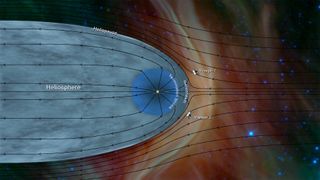Voyager 2's Trip to Interstellar Space Deepens Some Mysteries Beyond Our Solar System

NASA’s Voyager 2 spacecraft entered interstellar space in November 2018, more than six years after its twin, Voyager 1, did the same. Data from Voyager 2 has helped further characterize the structure of the heliosphere, the huge bubble the sun blows around itself.
(Image: © NASA /JPL-Caltech)
Humanity's second taste of interstellar space may have raised more questions than it answered.
NASA's Voyager 2 spacecraft popped free of the heliosphere — the huge bubble of charged particles that the sun blows around itself — on Nov. 5, 2018, more than six years after the probe's pioneering twin, Voyager 1, did the same.
The mission team has now had some time to take stock of Voyager 2's exit, which occurred in the heliosphere's southern hemisphere (as opposed to Voyager 1, which departed in the northern hemisphere). In a series of five papers published online today (Nov. 4) in the journal Nature Astronomy, the researchers reported the measurements made by the probe as it entered interstellar space.
Related: Photos from NASA's Voyager 1 and 2 Probes
These data are full of surprises. For example, Voyager 2 traversed the heliopause — the boundary between the heliosphere and interstellar space — when the probe was 119 astronomical units (AU) from the sun. (One AU is the average Earth-sun distance, which is about 93 million miles, or 150 million kilometers.) Voyager 1 made the crossing at nearly the same distance, 121.6 AU.
This consistency is "very strange, in the sense that one [Voyager 2's crossing] occurred at the solar minimum, when the solar activity is the least, and the other one occurred at the solar maximum," Stamatios Krimigis, lead author of one of the new Voyager 2 papers, said during a teleconference with reporters last week, referring to the sun's 11-year activity cycle.



No comments:
Post a Comment